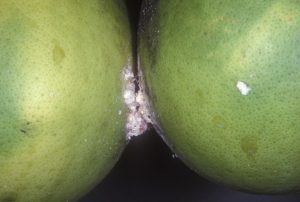Introduction
Citrus mealybug (Planococcus citri) is a common pest of citrus and ornamental plants in Florida. There are at least 27 plant families reported as a host for mealybugs. The pest is native to Asia, but it is also found in the Americas and Europe.
Characteristics
- Soft, oval, pinkish body, and covered with a white powdery wax along the body.
- The species are different in the thickness and length of the waxy filaments.
- They can be found between clusters of fruits, especially when ants are present in groves.
- The eggs are pink in color and will hatch in 2 to 10 days.
- Female mealybugs have no wings, and they travel short distances by crawling, or they are carried by ants, wind, birds, labor crews.
- Male mealybugs are small, winged insects.
Damage
- Wilted, distorted, and yellowed chlorosis leaves, stunted growth, leaf drop, fruit splitting, fruit discoloration, fruit drop, and occasionally death of infested plants.
- Sooty mold fungus grows because of honeydew secreted by mealybugs left on leaves and fruits. Sooty molds reduce the photosynthesis capacity of leaves.
- Commercially unacceptable fruits because of sooty mold on fruits
- Damage is most severe in the summer.
Control
- Citrus mealybugs are not easy to control. Their population should be monitored from March by examining the trunk and lower branches.
- In a small scale, you can remove them using a cotton swab dipped in rubbing alcohol, or by using a high-pressure water spray.
- Wash plants with mild soapy water (about 2% soap, not detergent) to remove wax left by mealybugs.
- Oil application will aid in suppressing mealybugs.
- Chemical control is most effective when the first mealybugs are observed.
- Pesticide can be sprayed weekly to control all new mealybugs hatched from eggs. Chemicals have been recommended for their control (For more information on chemical control, refer to Florida Citrus Pest Management Guide: Soft-Bodied Insects Attacking Foliage and Fruit.
- Hedging citrus groves to reduce contact between trees is useful for limiting the spread of the pest.
- Cleaning of equipment and harvest materials will help prevent the spread of mealybug.
- Biological control is the most effective method to control citrus mealybugs. Some parasitoid wasps as well as lady beetles, predaceous mites, lacewings, mealybug destroyers, and syrphid flies can aid in mealybug control.
- No single control method will control citrus mealybugs.
More information can be found here: Citrus Mealybug Planococcus citri (Risso) (Insecta: Hemiptera: Pseudococcidae)


 0
0
